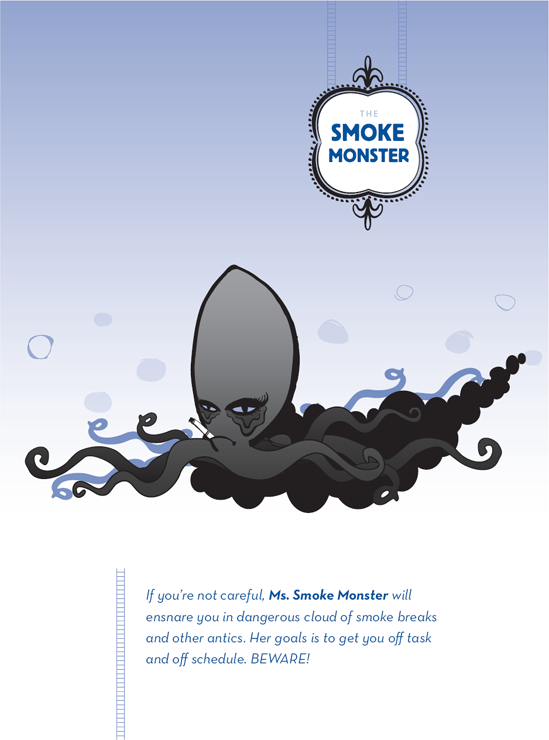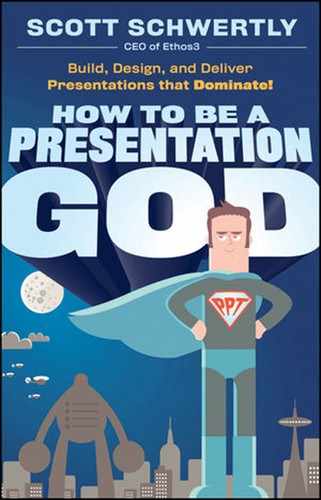Chapter 1. A Killer in Our Midst
French writer and Nobel Prize winner André Gide once said, "Society knows perfectly well how to kill a man and has methods more subtle than death." Subtlety, thy name is PowerPoint.
What is it about bullet points that makes the human soul curl up into a ball of fetal terror? Why do fonts like Comic Sans and Papyrus sear the retinas so badly? How can so-called "experts" speak at length about the logistical applications of advanced financial modeling yet fail to zip up their pants?
Most importantly, when are we, the victims, going to work up the courage to stand up and walk out, taking as many reeling audience members with us as we can? We should be disturbed. No—we should be outraged. Time—both yours and mine—is being wasted.
As the CEO and founder of the presentation design and training firm Ethos3 Communications, I set out to answer questions like these some years ago. I want to make the unjust world of presentations just again. Here's a staggering statistic: 30 million presentations are given daily in human society. Daily. With that much hot air entering the atmosphere every day, we must either cap and trade public speakers or revolutionize the way presentations are given. Since we don't have a way to safely store public speaker emissions yet, I vote for the revolution.
On one hand, our society has embraced the presentation as a necessary element of doing almost any kind of business—selling, producing, distributing, organizing . . . you name it. On the other hand, presentations are universally mocked as one of the least productive elements of business life—more so, even, than smoke breaks. Would-be audience members rifle through medical texts as they search for a way out. Unlucky attendees pore through religious tomes in a hunt for salvation. Despite the fact that we have mastered the art of entertainment—DVR, the iPad, and the ever-expanding capabilities of the Internet that have put happy diversions at our fingertips—we somehow can't quite seem to put together 17 minutes of meaningful information in an entertaining, influential format. PowerPoint has degraded, rather than elevated, the art of the presentation. We are all fleeing in the wake of this disaster.
As a result, the art of concealed distraction has advanced beyond the wildest dreams of a high school class clown. I've seen how adept many of you are with your smart phones. Once, in a close-quartered presentation, I witnessed an audience member tapping out an e-mail on a BlackBerry with his big toe. I couldn't blame the guy: we were confronting our very mortality as we gazed upon a mind-numbing chart designed in Excel. I, too, felt the need to reach out to loved ones in that moment of crisis. I know in my heart that there was a purpose for that presentation, just as I believe that all presentations have a purpose. But as it came to a close, I, along with every other attendee, walked away in bewilderment. Despite rapid advances in technology and psychology, few presenters are capitalizing on their presentation opportunities.

John F. Kennedy—a powerful presenter in his own right—once remarked, "The only reason to give a speech is to change the world." Of the 30 million presentations being given each day, how many do you think actually change the world? Better yet, how many presenters even set out to try? I understand that the third quarter budget approval meeting may not lend itself to epic prose and lectern-pounding passion; however, that doesn't mean that we have to read off a lifeless litany of figures in monotone without ever looking at the audience, as if to say, "I quite literally hate my life right now and resent the audience for being in any way associated with it." These are real human lives we're talking about. I firmly believe that a poorly planned, poorly delivered presentation represents a serious and threatening disregard for human life. We ought to present as though our audience only has two hours to live—one of which will be taken up by our presentation. How can we quickly and powerfully distill exactly what must be communicated so that they can get on with their goodbyes?
The reality for both audiences and speakers is that a presentation that does not move something—be it people, products, ideas, or values—is merely wasted time.
It is 20, 40, 60, even 90 minutes of real, living hours that are just thrown away. That's time that could be spent calling mothers, brushing teeth the right way, or just staring blankly at walls or clouds rolling by. It would be far nobler to set the bored masses free than to burden them with yet another presentation filled with information they already know and that is being presented with a level of energy reminiscent of an old, lazy, spineless Raggedy Ann doll and not the cartoon version that moved.

The opportunity to speak before an audience always represents a significant opportunity, notwithstanding the dismal state of most presentations and the time they waste. Each time a group of individuals gathers to listen, they set aside self-absorbing thoughts and, for a brief moment, are forced to think collectively. Just being part of an audience has this effect on the human mind. Presentations by nature call us to think on a bigger scale—one beyond personal limitations. They compel us to become greater than the sum of our parts. Most presenters defuse this power almost immediately by choking on a sip of water, telling a horrifically cliché joke, or opening the presentation with, "If you'll look at the pie chart on page 2. . . ." Everyone—and I mean everyone—is capable of doing better.
Think of FDR's fireside chats and of speeches such as Winston Churchill's Fight Them on the Beaches and Dr. Martin Luther King, Jr.'s I Have a Dream. Throughout history, presentations have moved large groups of frightened, embattled, and disenfranchised people to decisive action. These speeches did, indeed, change the world, but the scale of those opportunities is not our focus. Intention—the effort and preparation we bring to the moment—is paramount. For too long, I've watched presenters sell themselves, their messages, and their audiences short because the stakes were not high, or not high enough. If we are going to leave our mark on the world, we must begin where we are.
I'm not asking you to sell all of your belongings, grow a ZZ Top beard, and hit the New Age circuit, exhorting all who will listen to begin sharing each meal with abandoned kittens. If you're willing, that would be a truly nice thing to do for society and could seriously curb obesity trends while addressing our nation's feral kitty problem. However, feline-related karma reserves are not the scope of this book. This book is written to help you utilize presentation opportunities more effectively—plain and simple. Despite the fact that technology, psychology, and the business environment have changed drastically since the introduction of PowerPoint, few presenters have adapted their craft to this altered environment.
Ironically, great men and women have been changing history and the world for thousands of years without the aid of a Microsoft or Apple software suite. Technological tools should augment—not detract from—our presentations. Remarkable presenters build trust, win people, and deliver results; these are the speaker's mandates. People follow people worth following, and people become worth following when they exhibit qualities that every human being is inclined to admire and covet—passion, energy, and direction.
The concepts in this book will help you design, build, and deliver seriously effective presentations. But there is one thing the concepts in this book cannot do: make you extraordinary. Every presentation serves its master. The limitations of your personal hopes, dreams, and aspirations are the biggest inhibitor—or facilitator—of the presentation success you will encounter. Therefore, before we delve into content, design, or delivery, let's take time for introspection and ask ourselves: Are we worth following?
Do we possess the attractive qualities of passion, energy, and direction or are we waiting for some opportunity to come along that justifies the effort to be great? Today's speech may be routine information on home warranties at the local Rotary club, but who knows where that could lead? The only way not to find out is to give a lackluster presentation.
Be extraordinary. It's a tall order—one that I often forget to strive for myself. Not too long ago, I learned a trick that helps me focus: at the beginning of each day, I put five pennies in my right pocket. Since there's nothing a penny can buy anymore, I don't have to worry about accidentally spending them or being mugged. Each time I do something extraordinary, or just a little beyond my routine, capacity, or comfort zone—calling an old friend, helping a stranger, getting flowers for my wife for no reason—I move a penny to the left pocket. A complete migration of pennies from right to left reflects a truly meaningful day, one worth emulating tomorrow. Do this daily and watch the fruits of your life compound. Make it a lifestyle and you can comfortably lead people wherever you are going.
The extraordinary life may seem tangential to the requirements of the average presentation, but nothing gives information a sharp edge like a driven human being. The sole objective of any presentation is to initiate change in a certain direction chosen by the speaker. Moving people is easy: Show them Pauly Shore movies and you'll move them quickly to the doors. Moving people to work harder, think broader, or invest their resources in you are more difficult tasks that require planning, creativity, and execution for their achievement.

Life rewards commitment: Commit to being great, and you will be. If you commit to change the world, you will. In the following chapters, I'll go over my own methods for creating presentations that dominate. These methods will allow you to put a powerful edge on your message. I've helped hundreds of presentations go from disturbing to earth shaking over the years; I want to see more earth shaking. But you have to bring the passion and the vision. How big is your dream? Where are you going?
Powerful presentations have a way of putting life into hyperdrive. Can you handle that? Are you ready to put a little more in to get a lot more out? If so, it's time to join the Presentation Revolution.
